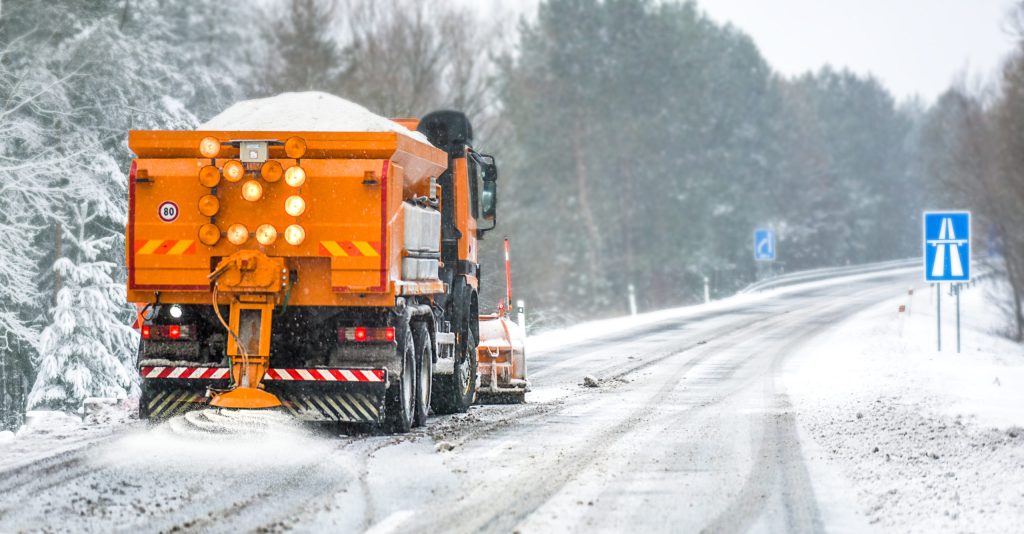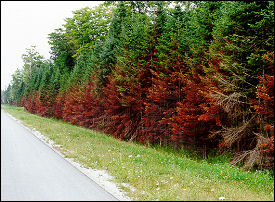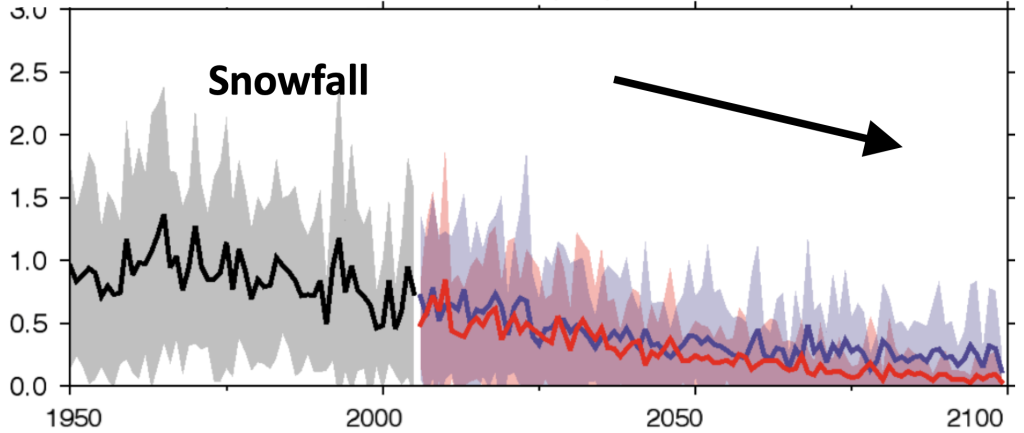Salt May Be Safe for Cars, but is it Safe for the Environment?
By Andrew Lebowitz, 2021-2022 Environmental Leader

Image Source: Shutterstock
On days with expected snowfall, in any Bethesda neighborhood, one is likely to walk down the sidewalk or street and hear a crumpling noise under foot. This noise is coming from the abundance of salt grains. These salts, while necessary for deicing roads, thus protecting cars and people, are actually a significant problem when released into the environment. This is called road-salt pollution.
Often underlooked, this type of pollution has a wide array of impacts on the environment, human health, and infrastructure. Salt, through runoff, accumulates in soil and water reservoirs. When in soil, salt absorbs groundwater, and tends to cause root dehydration in many types of plants, trees and grasses. As a result of dehydration, plants can acquire many abnormalities, one of which is stunted growth (Bayer and Njue 2016). Often, plants adjacent to sidewalks or roads get the worst of salt exposure, due to the spraying of rock salt from passing vehicles. As shown in the image below, this can result in plants turning an unhealthy brown or red shade.

Image: The Minnesota Stormwater Manual
Road Salt is especially dangerous as it gathers into bodies of water. According to the Maryland Department of the Environment (2016), the Potomac River is three times saltier than it was 25 years ago (in 2015). Sodium chloride is water soluble, making it incredibly difficult to remove from streams or rivers. As salt pollutes waterways, aquatic ecosystems are harmed, and fish become vulnerable to a plethora of malfunctions and diseases. Migratory fish, seeking freshwater to breed, may assess waters to be too salty, and their populations will suffer, finding nowhere healthy to have offspring. Other types of animals are affected as well by road salt. Birds and small mammals can be poisoned when ingesting the salts, and pets such as dogs and cats can become ill from it. Additionally, as waters become saltier, animals are more susceptible to dehydration (CWHC 2016).
The deterioration of Infrastructure is also a very significant conflict stemming from road salt usage. Salt corrodes metal and pavement over long periods of time, causing damage to bridges, roads, and sidewalks, as they become unstable and cracked (Butler 2020). This leads to expensive repair costs and unsafe conditions. Interestingly enough, “The salty water from the Flint River is what led to the lead pipe corrosion that caused Flint’s recent drinking water crisis” (Kliefoth 2019). When unmitigated, road salt can have extremely detrimental impacts on the environment, human health, and infrastructure. Therefore, its usage and effects must be heavily monitored to reduce ecological problems.
It is evident that road salt poses a real threat to the health of our region. So what strategies are being implemented locally? The Montgomery County Department of transportation has taken the following steps over the years to reduce salt usage (MCDE 2016):
- They utilize salt brine on many routes – a liquid solution that is 22 percent salt and 78 percent water – before, during and after winter weather events (This leads to less salt actually being used)
- They pre-wet rock salt to reduce the “bounce and scatter” effect of salt solids ricocheting off the highway. (This helps ensure the salt is used effectively and stays on the road)
- They work with weather forecasters to develop a treatment plan employing nearly 100 infrared sensors at key locations, along with mobile sensors, to determine conditions and target its storm deployment
These strategies have been effective in minimizing road salt usage, but the issue still looms because plentiful amounts of sodium chloride are still released into the environment. The cascade effect of global warming, however, has led to and will continue to cause a significant decrease in snowfall in the future, as seen in the graphic for Maryland snowfall amounts below:
Figure Source: https://www.geo.umass.edu/climate/stateClimateReports/MD_ClimateReport_CSRC.pdf
Ultimately, in the next several decades, road salt will be used to a minimum, not because of strategy, but rather the Earth’s rapid change in climate. Thus, at the pace we are headed, road salt pollution will not be as severe an issue in the long term, but we still need to reduce our usage as much as possible due to its negative effects today.
What can we do as individuals to help?
It is very common for people to purchase road salt for walkways, driveways, and more. Unless physically unable, we should try our best to manually shovel snow or ice instead of resorting to salt or other deicing chemicals. If it is necessary to put down road salt, don’t go overboard! “We use 30 times more salt than is needed on average (Kliefoth, 2019)”. Let’s reduce our salt usage, and protect the environment!
References
Bayer, M., & Njue, G. (2016, January N/A). The Impact of Salts on Plants and How to Reduce Plant Injury from Winter Salt Applications. University of Massachusetts Center for Agriculture, Food, and the Environment. https://ag.umass.edu/landscape/fact-sheets/impact-of-salts-on-plants-how-to-reduce-plant-injury-from-winter-salt
Butler, C. (2020, February 13). The Hidden Hazards of Road Salt. Pavement Solutions. https://pavementsolutions.org/effects-of-using-salt-to-melt-snow-ice/
Canadian Wildlife Health Cooperative. (2016, February 2). A Salt on Wildlife Health: The Environmental Impacts of Road Salt. Healthy Wildlife Blog. http://blog.healthywildlife.ca/salt-wildlife-health-environmental-impacts-road-salt/
Kliefoth, W. (2019, December 12). Study finds the Potomac is getting saltier, threatening drinking water and wildlife. Potomac Conservancy. https://potomac.org/blog/2019/2/11/potomac-river-salt-salinity-study-2019-n6hl4
Montgomery County Department of the Environment. (2016). Winter Salts. https://maryland.maps.arcgis.com/apps/Cascade/index.html?appid=b3c8425c387348659273eb889b007edb
About the Author:
 Andrew Lebowitz, 2021-2022 Environmental Leader
Andrew Lebowitz, 2021-2022 Environmental Leader
Andrew is a Senior at Bethesda-Chevy Chase High School. He joined Bethesda Green because he want to lend a hand in the fight against environmental challenges in his area. He plans to study environmental science and hopes for a career in which he gets to travel around the world in the pursuit of nature! Aside from his passion for the environment, he is an avid Washington football team fan and loves to play basketball.






